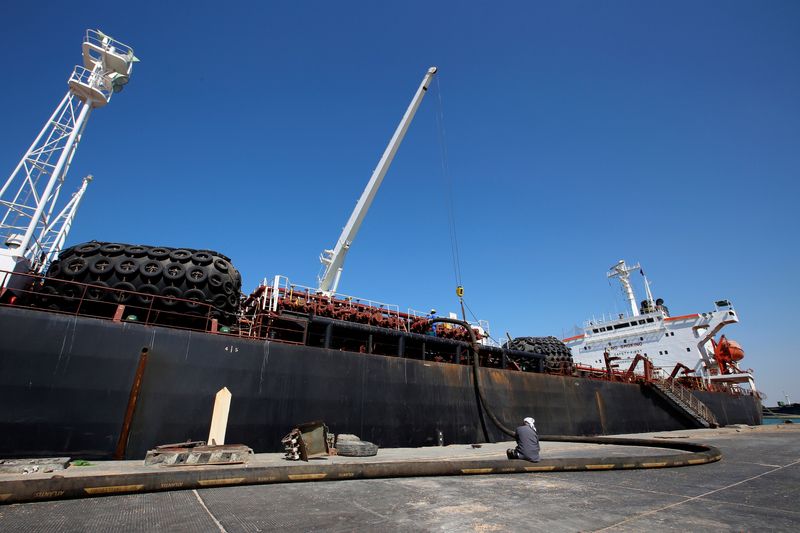By Marwa Rashad, Robert Harvey and Natalie Grover
QatarEnergy, the world's second-largest exporter of liquefied natural gas, has stopped sending tankers via the Red Sea (NYSE:SE), joining several other companies currently avoiding the world's main East-West trade route.
Yemen's Iran-backed Houthi group has since November been attacking vessels in the Red Sea, part of a route that accounts for about 12% of the world's shipping traffic, in what they say is an effort to support Palestinians in the war with Israel.
The attacks have raised the spectre of another bout of disruption to international commerce following the upheaval of the COVID-19 pandemic, and prompted U.S.-led air strikes on Yemen.
WHAT ARE THE LATEST DEVELOPMENTS?
At least four tankers used to carry Qatari LNG were held up over the weekend after U.S. and British forces responded by carrying out dozens of air and sea strikes on Houthi targets in Yemen.
"It is a pause to get security advice, if passing (through the) Red Sea remains unsafe we will go via the Cape," a senior source with direct knowledge of the matter told Reuters on Monday. "It is not a halt of production."
In the oil market, at least six more oil tankers have either diverted their course away from, or paused before entering the southern Red Sea since the weekend, ship tracking data from LSEG and Kpler show.
IS THE RED SEA ROUTE IMPORTANT FOR THE LNG MARKET?
The attacks have made reaching the Suez Canal more perilous.
About 12% of world shipping traffic transits the canal and 4%-8% of global LNG cargoes passed through it in 2023.
As much as 8.2 million barrels per day (bpd) of crude oil and oil products traversed the Red Sea in the January-November period of 2023, according to analytics firm Vortexa.
Around 16.2 million metric tons (MMt), or 51% of LNG trade, flowed from the Atlantic Basin east through the Suez Canal last year, while 15.7 MMt went through the canal from the Pacific Basin west, according to S&P Global (NYSE:SPGI) Commodity Insights.
WHO ARE THE MAIN SHIPPERS THROUGH THE ROUTE?
The Suez Canal is one of the most important arteries of the global oil trade.
Qatar, the United States and Russia are the most active shippers of LNG via Suez.
Qatar tops active shippers of cargoes heading from the East to Europe but nonetheless provides only around 5% of net EU and UK imports.
"In reality, Qatar is the only exporter in an east-to-west direction via the Suez Canal,” said Robert Songer, LNG analyst at date intelligence firm ICIS.
An alternative route to Europe through the Cape of Good Hope could add around nine days to the 18-day voyage from Qatar to Northwest Europe, said ICIS LNG analyst Alex Froley.
For LNG to Asia, Qatar comes on top followed by the United States which has been using the Suez Canal recently as an alternative to the Panama Canal.
ARE PRICES IMPACTED?
Asia spot LNG prices fell to a seven-month low of $10.10 per million British thermal units (mmBtu) on Friday, supported by healthy storage levels in Europe and northeast Asia. [LNG/]
High inventories in Europe and North Asia are capping demand and expected to curb spot price growth in H1-2024.
Oil prices rallied 2% last week, with both benchmarks notching intraday 2024 highs, including Brent eclipsing $80 a barrel, but prices eased on Monday as the conflict's limited impact on crude output prompted profit-taking.
"The realisation that oil supply has not been adversely impacted is leading last week's bulls to take profit," Tamas Varga of oil broker PVM told Reuters.
There have been no oil supply losses so far, but the shipping disruption is indirectly tightening the market by keeping 35 million barrels at sea owing to the longer journeys shippers have to take to avoid the Red Sea, Citi analysts wrote.
Insurance war risk premiums have gone up from $2,000 to $10,000 as a result of the disruption, and before the strikes by U.S. and Britain late last week, had jumped further to $30,000, a shipping source who declined to be named told Reuters.
HOW DO MARKET PLAYERS SEE THE RISK?
Crude and oil products market players said the extent of the impact will be determined by the duration of shipping disruptions as a result of the Houthi attacks.
It is unlikely that much will change unless situation goes on for longer than a couple of weeks, an analyst at a trading house said.
The delays are most likely to impact medium sour crudes from Middle East producers, which could be substituted with grades of similar quality from Brazil, Guyana and Norway, a crude trader told Reuters.
LNG market players believe LNG trade is likely to be largely unaffected and any disruption would not have a massive impact on global supply.
The majority believe that U.S. shipments, if they head to China/Asia, could only see short-term delay if cargoes reroute.
"The physical risks to Suez LNG transit are more weighted towards keeping Atlantic supply pointed at Europe than

stopping Qatari supply from reaching Europe," said Jake Horslen, senior LNG analyst at Energy Aspects.
The chairman of the Japan Gas Association (JGA), Takahiro Honjo, told a news conference that while there are risks, "I don't think a supply crunch will suddenly occur anytime soon".